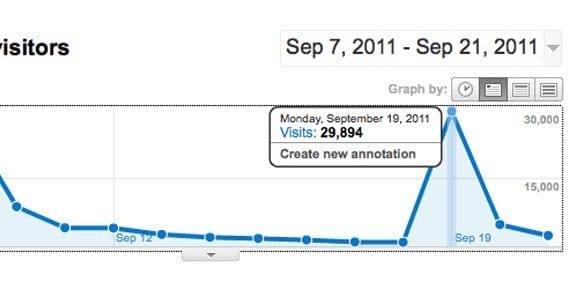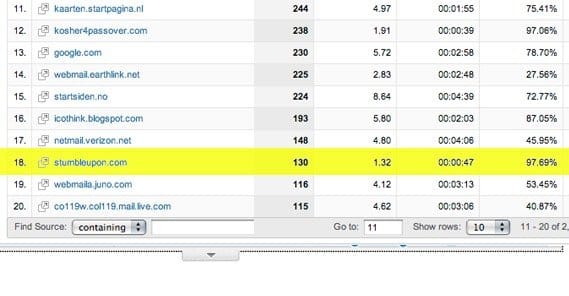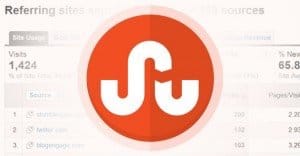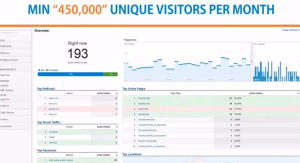A Detailed Review of Our Experiences with StumbleUpon Ads

StumbleUpon is a very interesting platform. From a user’s perspective, it’s a content discovery engine that brings you content you specifically ask to see, while leaving out content you don’t.
It can be a little off base, sometimes. If your interest selection is too narrow you’ll see the same handful of sites again and again. Sometimes you’ll see sites that aren’t really relevant to your chosen interests, due to miscategorization or ads. And, of course, you’ll often realize that a lot of the content in your interests isn’t really interesting.
How many times can you see the same sort of beginner’s guide to a topic, or the same selection of aggregated and shared content on a dozen different sites, before you get tired of it?
There are, of course, all of the additional social aspects of the site. Personally, I never really got into them. There’s a lot there, but it’s not really all that fun or interesting. I guess I could follow a few popular curators, but then I might as well be following a curator’s blog rather than using StumbleUpon itself.
The thing is, StumbleUpon has a huge number of users. As of September of this year, they report having 30 million active users. That can be a lot of traffic, if your content gets a few positive votes. Or, as StumbleUpon would certainly encourage, if you spend money on their paid discovery.
Paid discovery is one of the more unique forms of paid advertising on the web. It doesn’t throw your content into sidebar ads or into a news feed. Rather, it just prioritizes your content in the rotation of stumbles. You’re still organically in rotation as well, and people can find you naturally, but they will also find you through your paid priority. Organic stumbles don’t count against your budget, but then, it’s up to Stumble to report whether a user came from paid or organic discovery.
Some people report a lot of success with StumbleUpon, while others report nothing but misery. Advocates will promote it to their dying breath, while detractors will rail against it. The schism comes from a problem I see time and again in web marketing. That is, no one seems to take niche into account. What works for one person won’t necessarily work for another, but most people seem to forget that different niches behave differently.
The simplest example of this is just the difference between Pinterest and, say, Slashdot. If you are running a technology site that digs into the differences between various processor architectures and motherboard designs, you’d probably have more success on the tech-focused Slashdot. On the other hand, if you’re crocheting adorable animals to sell to the parents of young children, Pinterest is a much better target.
So, what does StumbleUpon bring to the table, and where does it fall flat?
Tons of Traffic
The number one reason to use StumbleUpon, either organically or through paid discover, is the volumes of traffic you can get. As I said, there are some 30 million active users on the site. It’s no Facebook, but it’s no slouch either.
Many people will report that they have put their content up on StumbleUpon and gotten essentially nothing out of it. I’ve certainly seen cases where adding content to Stumble only send a few dozen hits, if that. The problem here tends to be a poor start. Stumble works on a sort of internal voting algorithm. Users can thumbs up or thumbs down content they see in order to a) remove the content they don’t want from rotation and b) see more of the content they want.
If you add your site and the first few people to see it decide they don’t like it – either because they don’t like the post itself or they don’t like your brand, site design, or another aspect of the situation – your post will very quickly fall out of rotation. It’s much like Reddit in this way; if you get a handful of downvotes immediately, no one will see your content, because it’s hidden.
Paid discovery helps you here in two ways. For one thing, it guarantees more traffic. Depending on your budget and your targeted interest categories, you might get a hundred guaranteed views or a few thousand. You probably aren’t going to be paying for much more than that, but who knows, maybe you will.
For the other thing, it forces your content to show up even if it’s initially downvoted. This gives you a greater chance of getting more positive votes, which will drag you out of the initial hole and back into circulation.
So, what about my personal experiences? I’ve run paid StumbleUpon traffic targeted at a number of different sites across different niches, and I can tell you one thing; you get a lot of traffic. I’ve had quality web hosts start to shake a little under the pressure. It is, however, a very much on-or-off system. You don’t really get a lot of opportunity to spread the traffic out over time. You turn it on full blast, or you shut it off, and it depends on your available ad spend.
So, that’s probably the biggest perk of using Stumble’s paid discovery. You can get a lot of traffic in a very short amount of time. If you have some content that’s highly interesting and quite likely to go viral, turning the fire hose on it is a good way to get a lot of initial exposure.
Tons of Bounce
So what about the downsides? The biggest downside of them all is the bounce rate. To understand it though, let’s take a look at StumbleUpon from the user side again.
When you’re using StumbleUpon, you essentially have three buttons. There are more, but they’re not as important unless you’re using the social network features of the site. So, ignoring the fact that you can add it to your curated feed or leave a comment, you have three total actions.
- Upvote the content, which adds it to a list of content you have upvoted, which other users can browse if they like.
- Downvote the content, which removes that page from your rotation, tells the Stumble algorithm that you don’t like that specific type of content, and sends you to the next page in your rotation.
- Hit the stumble button to go on to the next page in your rotation without interacting with the current page.
This does of course discount any actions the user can take on the site itself, like clicking around, opting in, buying, commenting, or whatever else. I don’t consider these actions a user can take because, quite frankly, most users let their mouse cursor hover over the stumble button and are prepared to click it if the site they land on doesn’t immediately entertain them.
Back to my personal experiences, remember where I said I got a ton of traffic from Stumble? It was as fickle and fleeting as a dream. I’m talking 90% bounce rates, minimum, across every experiment. The people who come in from Stumble are very, very quick to leave if you don’t give them exactly what they want, immediately.
I imagine the way to hook them and keep them in is through a mixture of techniques used by The Great Horrible Web Exploiters, Buzzfeed and Upworthy. Stumble has no rules against clickbait or thin content, so sometimes that’s just what you need. If you do it, be sure to tell me how selling your soul for StumbleUpon traffic feels, it’s not an experience I’ve had.
Assorted Issues
There are a bunch of other issues with StumbleUpon traffic, primarily their paid traffic.
For one thing, while I got a few social media shares from each experiment, they weren’t very high. If the average shares for a post on a site was 30, we’d be talking in the low 40s tops. That’s, again, with a very high bounce rate. Maybe the people who stuck around were interested enough to share, but it’s still a very low percentage of incoming traffic.
Another issue is comparative reporting. Sometimes Stumble seems to remove UTM parameters and other tracking code from the URL it promotes. This leads to a disconnect between incoming traffic as reported by StumbleUpon, and incoming traffic as reported by Google Analytics. Without tracking parameters, the traffic looks like direct traffic, which is notoriously hard to analyze.
As with any form of marketing, accurate reporting is necessary to come to accurate conclusions about what is and isn’t working. When StumbleUpon is seemingly dropping as much as 25% of your traffic, they look no better than some of the shadier traffic sellers out there.
Remember that with Stumble you’re not paying for clicks. It’s a lot more like pay per impression marketing than it is pay per click marketing. With traditional PPC, you’re getting ad impressions for free, and only paying when a user clicks on your ad to visit your site. With StumbleUpon, the user clicks a button and your site comes up, but it’s not an ad and it’s not their choice to visit your site. You’re not getting free impressions, you’re paying for impressions, and your entire page is the ad. That’s part of why you have such a high bounce rate and poorly engaged traffic; that initial filter isn’t in place.
On the plus side, the cost of visits is pretty cheap. It’s around 10-15 cents per visit, which really isn’t that bad. It means a budget of $100 will get you around 650-750 visits, more or less.
Brad Knutson of ShareTally experienced the same thing with his campaigns, and he went one step further and installed a heatmap. Of the 558 visitors he recorded, he only had 13 clicks in areas of his site that matter. That’s hilariously bad.
He does note that some of the very few engaged users he had come in from StumbleUpon did actually really seem to like his product. They spent a lot of time exploring and using his page and service, and it’s entirely possible that he found an influencer or two in there who led to his future success. Or it’s entirely possible that these few engaged users were incidental to his success. Either way, $100 for less than 10 highly engaged visitors is not a very good conversion rate.
How to Benefit from StumbleUpon Traffic
I may seem highly down on StumbleUpon, and I kind of am. It hasn’t worked out very well the few times I’ve used it. However, I’m not going to make the mistake I mentioned way at the beginning. I know that different sites do find success in different areas, and the sites I’ve tested simply haven’t been the right kind of sites to succeed. That said, having used Stumble as a user and as a marketer, I have some insight into how it could work to someone’s advantage.
The first thing to know is that StumbleUpon’s interest categories are sort of a red herring. They have hundreds of categories, and you might assume that there is a relatively equal distribution of traffic amongst them. You would be wrong to make that assumption. I would venture to guess that the majority of the traffic coming from StumbleUpon is interested in a few limited categories. If your site falls into one of those categories, you’ll have a hell of a lot more potential than you will in other less trafficked categories.
The second thing to know is that StumbleUpon users are like children with ADHD who have been drinking espresso all morning. They have an average attention span of a third of a nanosecond. If your site doesn’t load very quickly half of them will be gone before it even fully loads. Even if it does load quickly, you need to capture their attention immediately. I mean instantly, not “if the read the first paragraph” or “oh if they just scroll down a little.”
Infographics are one way to capture attention immediately. A good infographic stuffed up top with social sharing buttons and an article below can be very successful. AJ Ghergich reported seeing $50 in paid discovery kick off 14,000 stumbles for infographics.
So, certain types of content work better. Infographics obviously work, though you do need to make sure your graphic is high quality and original. Interactive content tends to work well as well. Anything that draws a user’s cursor away form the Stumble button and down to your content is likely to make them forget about Stumble and spend a while exploring your page.
One of the best forms of content is games, but that’s not relevant to most businesses. If you’re a site that hosts games, like Flash games or any sort of browser game, you can attract a lot of attention. Even better if you don’t require a registration. Kongregate is an example of a site that would be able to get a ton of traffic from StumbleUpon, particularly if each game they host had its own entry in Stumble. For that matter, maybe they do.
With a high bounce rate and low engagement, you also want your content to encourage other forms of value. Highly prominent social media sharing buttons will help. Get users to click something other than the Stumble button, and hope that button benefits you in some way.
The flip side of all of this is that you absolutely won’t see any success on StumbleUpon with traffic that’s directed at pages of any complexity. If a user has to scroll down, look around, or visit an About page to figure out what your site is all about, they aren’t going to. They have better things to do, like skip a different site instead of skipping yours.
So how can you try to make sure you get more targeted traffic, less bounces, and more engagement? It’s difficult.
For one thing, you’ll probably end up wanting be very strict in the pages you submit to StumbleUpon. You don’t want your account to be restricted in some way for consistently submitting content that isn’t interesting and is downvoted. I tend to lean towards submitting landing pages, infographics, and highly interesting blog posts with very clickbait-like titles. Anything with more complexity or that requires more reading comprehension won’t work.
For another thing, limit your ad budget. Stumble traffic is just to get the ball rolling on a viral surge. You’re not going to rely on paying for a lot of traffic, you’re going to use an initial investment to seed a bunch of upvotes to get your content shared more. $50 or $100 is plenty of budget for all but the most highly pushed content.
 ContentPowered.com
ContentPowered.com








